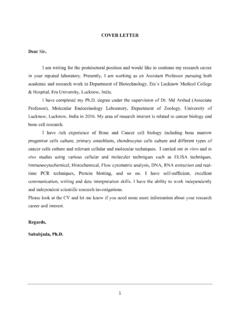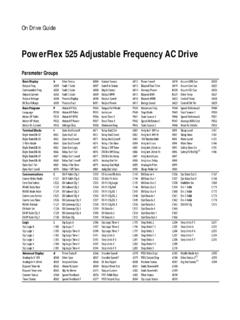Transcription of SARS-CoV-2 Omicron spike mediated immune escape ...
1 SARS-CoV-2 Omicron spike mediated immune escape , infectivity and cell-cell fusion Bo Meng1,2, Isabella Ferreira1,2, Adam Abdullahi1,2, Steven A. Kemp1,2, Niluka Goonawardane 1,2, Guido Papa3, Saman Fatihi4, Oscar J. Charles5, Dami Collier1,2, CITIID-NIHR BioResource COVID-19 Collaboration, The Genotype to Phenotype Japan (G2P-Japan) Consortium, Jinwook Choi6, Joo Hyeon Lee6,7, Petra Mlcochova1,2, Leo James3, Rainer Doffinger2, Lipika Thukral4, Kei Sato8,9*, Ravindra K Gupta1,2,10* 1 Cambridge Institute of Therapeutic Immunology & Infectious Disease (CITIID), Cambridge, UK. 2 Department of Medicine, University of Cambridge, Cambridge, UK.
2 3 MRC Laboratory of Molecular Biology, Cambridge, UK. 4 CSIR Institute of Genomics and Integrative Biology, Delhi, India 5 Division of Infection and Immunity, UCL, London 6 Wellcome-MRC Cambridge Stem Cell Institute, Cambridge, UK. 7 Department of Physiology, Development and Neuroscience, University of Cambridge, Cambridge, UK. 8 Division of Systems Virology, The Institute of Medical Science, The University of Tokyo, Tokyo 1088639, Japan 9 CREST, Japan Science and Technology Agency, Saitama 3220012, Japan 10 Africa Health Research Institute, Durban, South Africa. *Address for correspondence: Key words: SARS-CoV-2 ; COVID-19; Omicron variant; ; antibody escape ; neutralising antibodies; infectivity; spike mutation; evasion; resistance; fitness; fusion; syncytia, ChAdOx-1, BNT162b.
3 Abstract The Omicron variant emerged in southern Africa in late 2021 and is characterised by multiple spike mutations across all spike domains. Here we show that the Omicron spike confers very significant evasion of vaccine elicited neutralising antibodies that is more pronounced for ChAdOx-1 adenovirus vectored vaccine versus BNT162b2 mRNA vaccine. Indeed neutralisation of Omicron was not detectable for the majority of individuals who had received two doses of ChAdOx-1. Third dose mRNA vaccination rescues neutralisation in the short term. Despite three mutations predicted to favour spike S1/S2 cleavage, observed cleavage efficiency is lower than for wild type Wuhan-1 D614G and Delta.
4 We demonstrate significantly lower infectivity of lung organoids and Calu-3 lung cells expressing endogenous levels of ACE2 and TMPRSS2 but similar infection as compared to Delta when using H1299 lung epithelial cells. Importantly, fusogenicity of the Omicron spike is significantly impaired, leading to marked reduction in syncitia formation. These observations highlight that Omicron has gained immune evasion properties whilst compromising on properties associated with replication and pathogenicity. Introduction The Omicron variant was first detected in South Africa and has now spread internationally1.
5 It has been associated with very rapid increases in case numbers and recent data demonstrate significant evasion of neutralising antibody responses1. Omicron appears to be competing with the Delta variant in the UK and this may be due to an advantage in vaccinated / previously exposed populations and/or increased replication. Data on replication are limited however. Delta spike was previously shown to confer more efficient cell-cell fusion kinetics compared to Wuhan-12, and syncytia formation has previously been associated with pathogenesis3. Moreover, changes in the PBCS have been associated with pathogenicity.
6 Omicron has three mutations in the furin cleavage site region (P681H, H655Y and N679K) and has therefore been predicted to be highly infectious and fit. Here we show that contrary to predictions based on mutational profiling of the PBCS region, Omicron spike is relatively poorly cleaved, and impaired in mediating cell-cell fusion and syncytia formation. This reduced cleavage is also associated with poorer entry into target lung organoids or cell lines expressing endogenous levels of receptors. We also show that as expected from mutational profiling, Omicron has significantly reduced sensitivity to neutralising antibodies and that AZ vaccine sera display lower titres as compared to mRNA vaccine sera.
7 Soon after a third dose with mRNA however, robust titres against Omicron can be achieved, thus supporting third dose boosting strategies. Results The Omicron spike protein shows increased intramolecular bonding, changes in charged residues and multiple mutations across domains. We first sought to investigate the distribution of mutations and their impacts. We observed increased intramolecular hydrogen bonds in Delta and Omicron compared with Wu-1 (Figure 1a). In addition when we simulated interactions with ACE2 Omicron displayed multiple contacts with ACE2 in contrast to Delta and Wu-1 (Figure 1b).
8 When charge at the protein surface was modelled there was again a striking difference between Omicron and earlier variants, in particular with positive charge accumulating in the RBD (Figure 1c). Omicron spike protein confers broad escape from two dose vaccination with adenovirus vectored and mRNA vaccines We next synthesised codon optimised spike expression plasmids for Omicron and Delta spike proteins and generated PV particles. We obtained longitudinal serum samples from individuals vaccinated with either BNT162b2 or ChAdOx-1 vaccines. We observed more than ten-fold loss of neutralisation against Omicron after the second dose compared to Delta.
9 Indeed neutralisation of Omicron was not detectable for the majority of individuals who had received two doses of ChAdOx-1. We additionally also observed waning over time since second dose (Figure 3). Both groups were boosted with BNT162b2 as a third dose, allowing us to compare the response to this boosting dose. Significant increases in neutralisation were observed for all variants tested, suggesting increased breadth of responses as well as titre. Omicron spike protein induces relatively poor cell-cell fusion compared to Delta Mutations at P681 in the PBCS have been observed in multiple SARS-CoV-2 lineages, most notably in the Alpha variant4 and the Delta variant.
10 We previously showed that these spikes, bearing P681 mutations, had significantly higher fusogenic potential than a D614G Wuhan-1 spike 5. Omicron bears P681H, in addition to 679 and 655 mutations (Figure 4a). We tested Omicron spike using a split GFP system to monitor cell-cell fusion (Figure 4b). We transfected spike bearing plasmids into Vero cells stably expressing the two different part of Split-GFP, so that GFP signal could be measured over time upon cell-cell fusion (Figure 4b,c). We observed increased fusion for Delta as compared to D614G Wuhan-1 spike as shown previously. The Omicron spike however resulted in very poor fusion (Figure 4d), despite being expressed (Figure 4e).



